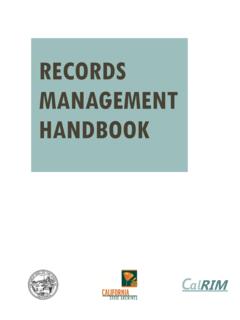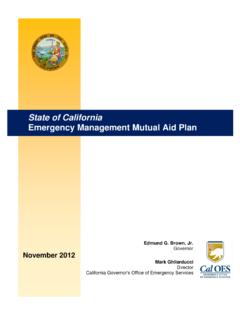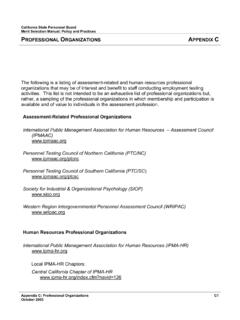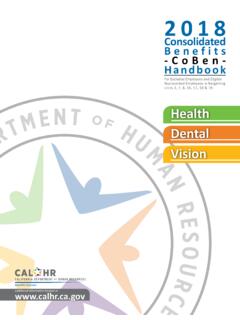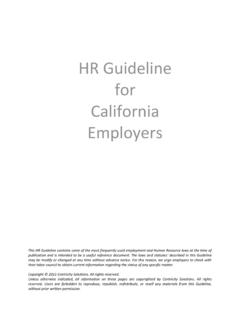Transcription of RECORDS MANAGEMENT HANDBOOK - California
1 RECORDS MANAGEMENT HANDBOOKR ecords RetentionRecords Retention HANDBOOK Introduction / RMC STATE OF California RECORDS MANAGEMENT HANDBOOK RECORDS RETENTION The RECORDS MANAGEMENT Program section of the State Administrative Manual (Chapter 1600) defines the responsibility of each agency to implement a RECORDS MANAGEMENT program and prescribes the procedure for scheduling and disposing of RECORDS . This RECORDS Retention HANDBOOK supplements the information in the State Administrative Manual and the procedural publications displayed on the California RECORDS and Information Program s (CalRIM) website While the HANDBOOK has been written primarily to assist agency RECORDS MANAGEMENT coordinators, it will also be useful to Legal Staff, file room supervisors and other interested agency By: California RECORDS and Information MANAGEMENT Program (CalRIM) California State ArchivesOffice of the Secretary of StateJuly 21, 2014 AbbreviationsCalRIM - California RECORDS and Information ProgramRMC - RECORDS MANAGEMENT CoordinatorRRS - RECORDS Retention ScheduleSAM - State Administrative ManualSRC - State RECORDS CenterSRAP - State RECORDS Appraisal ProgramForms AbbreviationsSTD 70 - RECORDS Inventory Worksheet, STD 70 STD 71 - RECORDS Transfer List, STD 71 STD 73 - RECORDS Retention Schedule, STD 73 STD 76 - State RECORDS Center Reference Request, STD 76GS-50 - State RECORDS Special Authorization, GS-50 RECORDS Retention HANDBOOK Introduction / RMC TABLE OF CONTENTS RECORDS Retention HANDBOOK Page Introduction 1 Establishing the Program 2 Steps in Establishing the Program 3 RECORDS MANAGEMENT Coordinator 4 What are RECORDS 5 Preparing for the Inventory 6 What Information is Required for the Inventory?
2 6 RECORDS Inventory Worksheet (STD 70) 9 RECORDS Inventory Worksheet (Instructions) 10 RECORDS Appraisal and Scheduling 11 Determining Retention Periods 12 What is a RECORDS Retention Schedule? 13 RECORDS Retention Schedule (STD 73) 14 RECORDS Retention Schedule (Instructions) 16 Creating the Schedule 18 Approval of Retention Schedules 19 Amending Retention Schedules 19 Applying Retention Schedules 20 Keeping Retention Schedules Current 21 State RECORDS Center Services 22 Instructions for Transferring RECORDS to the State RECORDS Center 23 RECORDS Transfer (SList TD 71) 27 RECORDS Transfer List (STD 71, Instructions) 28 Vault Storag foe r Vital RECORDS 29 Instructions for Referring to RECORDS Stored in the State RECORDS Center (SRC) State RECORDS Center Reference Request (STD 76) 30 31 32 33 35 36 37 Emergency Requests Instructions for Reviewing RECORDS at the State RECORDS Center Instructions for Destroying RECORDS Stored at the SRC Instructions for Preparing GS-50, State RECORDS Special Authorization State RECORDS Special Authorization (GS-50, Blank Form) Instructions for Preparing GS 50 (Reverse Side)
3 Instructions for Transferring RECORDS from Offices or Departmental Storage for Disposal 38 39 52 53 Authorization for RECORDS Destruction (Printout)Glossary of Terms RECORDS MANAGEMENT Program Chec klist Guidelines for Justifying Purchase of Filing EquipmentChecklist for Pre-Purchase Considerations and Reviews 54 for Electronic RECORDS Systems Sanctions for Failing to Locate RECORDS for Pre-Trial Discovery 55 40 30 RECORDS Retention HANDBOOK Introduction / RMC Our ability to control RECORDS has not kept pace with our ability to create them. We have computers that print multiple legible copies, high-speed copiers and duplicating machines that grind out reams of paper, word processors that facilitate the writing process and e-mail systems that produce thousands of communications daily. In today s highly technical environment the majority of our RECORDS are created and maintained electronically. The creation of paper copies is considered counterproductive and discouraged by RECORDS managers but paper holdings continue to lack of control over the creation, maintenance, retention and disposition of RECORDS manifests itself in a number of ways.
4 Look, for example, at your own agency. Do you know how many RECORDS you have and where they are? Who uses those RECORDS and how often? Do you know how much it costs to store your RECORDS ? Do you know how much time is wasted on the maintenance of inactive RECORDS ? Do you know how much money you have invested in filing equipment? Does your agency have retention schedules that account for all of its RECORDS ? Are the schedules being applied? If you have retention schedules, when did you last review them to see if the retention periods should be changed? WHAT IS RECORDS MANAGEMENT ? California s RECORDS MANAGEMENT Program is designed to ..apply efficient and economical MANAGEMENT methods to the creation, utilization, maintenance, retention, preservation and disposal of state RECORDS (Government Code 12272 (a)). The end result of this effort is to ensure that information contained in the state s RECORDS is available when and where it is needed at the least possible cost.
5 This HANDBOOK deals with several elements of a RECORDS MANAGEMENT program: the inventorying and scheduling of RECORDS owned by an agency; the systematic transfer of inactive RECORDS from office to storage; and the regular destruction of RECORDS that no longer have value. Properly managed, RECORDS protect personal and organizational rights, and support, defend, and account for the state s business RETENTION SCHEDULES RECORDS retention schedules are written policies outlining the treatment of state RECORDS regardless of format. They are a plan for the use of a business resource, just as a budget is a plan for the use of money. Properly prepared schedules save physical and electronic storage space by removing from offices RECORDS that no longer have significant value; and by maintaining a regular, controlled flow of RECORDS from physical and electronic storage receptacles to multi-media vital RECORDS storage facilities, state RECORDS center storage, or scheduled destruction.
6 The State of California uses STD 73, RECORDS Retention Schedule to: 1 INTRODUCTIONR ecords Retention HANDBOOK Introduction / RMC Save Space by removing from offices RECORDS that are not required for dailyoperations; by removing from storage areas RECORDS that no longer havesignificant value; and by maintaining a regular, controlled flow of RECORDS fromto storage to destruction. Save money by controlling the purchase of equipment and supplies to fileunneeded RECORDS ; by providing inexpensive storage facilities for less activerecords; and by releasing surplus paper filing equipment, micrographicreaders/printers/storage containers for re-use or sale. Save time in locating RECORDS by removing inactive material from office files; byencouraging the use of computer-assisted retrieval systems whereby the agencyknows what RECORDS it has and where they are kept; and by providing an orderlymethod of storing inactive RECORDS under the supervision of trained recordscenter THE PROGRAM To establish a successful RECORDS MANAGEMENT program, several important tasks must be accomplished.
7 First, top MANAGEMENT must be made aware of the goals of the program and the importance of achieving them. Secondly, an ongoing relationship between top/mid-level MANAGEMENT and RECORDS MANAGEMENT staff must be strengthened and maintained. This can be accomplished by keeping middle and top MANAGEMENT officials informed of changes in RECORDS MANAGEMENT policy and by inviting them to attend California RECORDS and Information MANAGEMENT Program (CalRIM) training events and technology MANAGEMENT support for the program has been obtained, the agency must develop the means for putting RECORDS MANAGEMENT into effect. While most RECORDS MANAGEMENT activities will be accomplished at the operating unit level, there is a continuing need for middle and top MANAGEMENT highly motivated and knowledgeable facilitator should be assigned the task of keeping the program moving. In most cases, the agency RECORDS MANAGEMENT Coordinator (RMC) is the most logical choice for this role.
8 Most importantly, responsibility for the function must be assigned at a level within the organization that has access to program managers and senior MANAGEMENT RECORDS Retention HANDBOOK Introduction / RMC STEPS IN ESTABLISHING A RECORDS MANAGEMENT PROGRAM Take an inventory of record holdings Retain the results in the active files until the next inventory Appraise all RECORDS Identify RECORDS , determine their location and who is responsible for them. Establish retention periods and special instructions Meet with knowledgeable person and negotiate retention periods. Use retention instructions shown on the CalRIM website ( and Chapter 1600 of the State Administrative Manual. Develop the Retention Schedule Using the STD 73, RECORDS Retention Schedule and the completed inventory, develop the retention schedule. Approve the Retention Schedule Review the completed STD 73 for accuracy and obtain the approval of the manager responsible for the RECORDS , Agency RECORDS MANAGEMENT Analyst and the CalRIM Consultant.)
9 Apply RECORDS Retention Schedule Rules Educate staff to comply with the rules established by the retention schedule. Transfer eligible RECORDS to the State RECORDS Center per instructions shown on the Retention section of the schedule. 3 RECORDS Retention HANDBOOK Introduction / RMC RECORDS MANAGEMENT COORDINATOR An agency RECORDS MANAGEMENT Coordinator (RMC) is the liaison between a state department, board, commission or agency; California RECORDS and Information MANAGEMENT (CalRIM); and the State RECORDS Center (SRC).The RMC shall be appointed in writing by the Chief Administrative Officer of the agency. CalRIM then looks to the RMC to answer questions and to certify that the agency is in compliance with the RECORDS MANAGEMENT Act, Section 1600 of the State Administrative Manual (SAM), and this HANDBOOK . On behalf of the agency, the coordinator shall: Coordinate the agency RECORDS MANAGEMENT program. Conduct research into RECORDS retention requirements.
10 Act as a liaison between the agency and CalRIM. Review and approve the STD 73 (RRS) and monitor subsequent destruction ofrecords or transfer of RECORDS to the State Archives regardless of whether theyare stored in-house or at the SRC. Review and approve purchase or rental of filing equipment and desk-topshredders. Be responsible for reports (including the Annual Report on RECORDS Managementto the Governor) required by the CalRIM for administration of the program. Disseminate announcements of RECORDS MANAGEMENT activities. Coordinate the scheduling of appropriate training for agency recordsmanagement personnel . Attend CalRIM RECORDS MANAGEMENT Coordinators Semi Annual meetings andsponsored technology INVENTORY Although many offices try to skip this step, some sort of physical inventory of the holdings is essential for a complete understanding of what RECORDS are generated and utilized within each work station. The physical inventory looks at RECORDS holdings on a RECORDS series basis rather than examining the contents of individual establish a RECORDS retention program, it is necessary to find out what RECORDS there are, where they are stored, their quantities, and how they are used.
